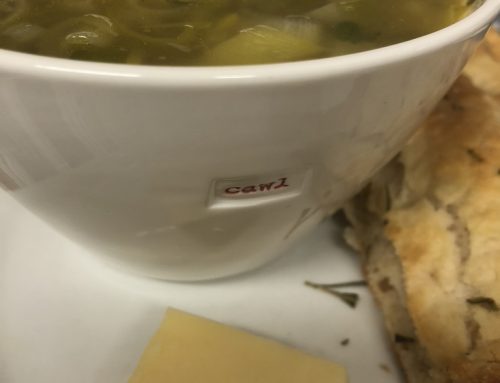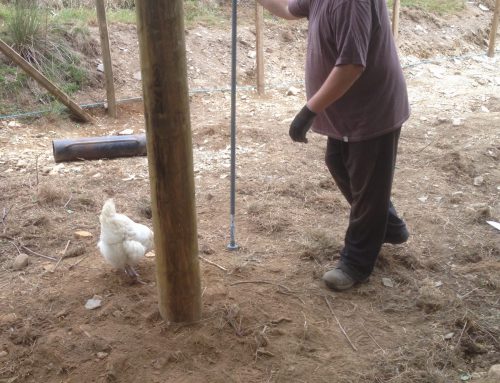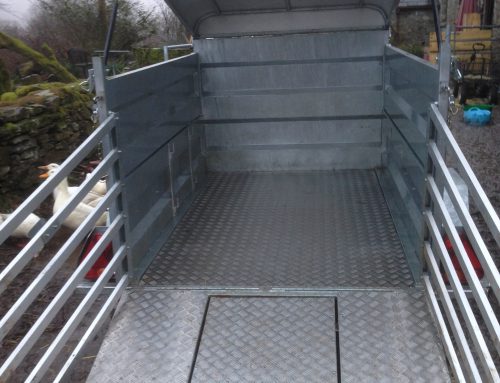Our wish list of animals we wanted to raise on our Smallholding did not include ducks, but when a paddling of five ducks came up for sale locally they seemed to be the next step. We named our four beautiful Aylesbury ducks Francis (the drake), Mrs Yellow, Mrs Pink and Mrs Green (to match their leg rings) and the noisy Pekin, Jemima. The breeder advised us that she was downsizing her flock and these were last year’s hatchlings. They had not been handled much but each one felt like a soft warm cuddle in my arms. We converted the stable next to the chickens into a duck house and gave the ducks a large feed trough as a paddling pool, a dog bowl for drinking water and another for food.
Ducks like to grab a mouthful of food and then a mouth full of water (they filter plant material, small fish, tadpoles, snails and such like, through the serrations on their bills). The result of this instinctive behaviour using duck pellets is a messy porridge of food at the bottom of the water bowl within minutes. This coupled with the very wet incontinent end result from eating and drinking a lot makes ducks very messy indeed and makes chickens look positively clean by comparison. Looking back four months on, I now question my own sanity that I thought hatching our ducklings would be a good idea. We have five 3 week old ducklings another 7 in one incubator due to hatch next weekend and 14 more in our second incubator due in 3 weeks. In anticipation of what could be another 21 birds, we are now registered with Animal Health for chickens and ducks (50+ birds).



The journey to potentially 30+ ducks (really shouldn’t count your ducklings before they hatch) has been an interesting one. We set 7 batches of 8 eggs in the incubator; picked 8 healthy eggs, marked an ‘x’ on one side and an ‘o’ on the other side with a pencil to help with turning, religiously turned them 3 times a day and candled them on day 9 (ducklings hatch in 28 days, chicks in 21) to find batch after batch of eggs infertile. I started to question whether Francis the drake was infertile or simply related to his Aylesbury ducks, as this could affect fertility. I found a lady in Carmarthenshire selling a four year old Aylesbury drake who thought Francis may be a bit young for the task in hand and suggested we swap drakes. She wanted a different drake as she now had daughters of her drake at laying age. We met in a CoOp car park about half way between us and swapped drakes in cardboard boxes. We got odd looks from shoppers and I brought home Moby, who proved himself up for the job by mating Mrs Pink without seconds of meeting her, on the gravel outside the duck house, wham bam thank you ma’am (ducks usually mate in water). 7 out of 8 eggs set since acquiring Moby proved fertile and 5 ducklings successfully hatched.



This first hatching was a steep learning curve. First there was candling which involves shining a strong a light beam through the blunt end of the egg allowing the light to penetrate the shell and illuminate the inside (at the start of incubation to check for imperfections in the shell). Candling 1/3 way through incubation should reveal any infertile or clear eggs and the size of the air sac is monitored as this gives an indication of humidity levels. The first time we saw blood vessels and movement in the eggs was amazing, after 7 batches of clear eggs we were very excited. Any infertile eggs are removed from the incubator. Candling is repeated 2/3 way through incubation to monitor continued development, and the size of the air sac as a moisture indicator. Optimum temperature (37.4-37.6 celisus for chicken and ducks) is important for healthy development, although embryos can tolerate short periods of temperature drops (when eggs are turned to prevent the embryo sticking to one side of the shell or during candling). Hatch rates can be affected by high temperatures.



Humidity plays a huge part in hatching in an incubator, nature has this covered as the duck would sit on the eggs with wet feathers (we make it so complicated). In an incubator optimum humidity (45-55% for ducks and 40-50% for chickens) achieves ideal weight loss during incubation (13-14%); eggs lose moisture through their shells. A higher level of humidity (65% plus) is important for hatching to prevent membranes drying and hardening before the hatch fully emerges. As the first eggs begin to hatch and membranes begin to dry, humidity will increase and if the incubator is opened the humidity level will fall dramatically and take time to build up again. This is one of the reasons why the temptation to assist a hatchling must be resisted and opening the incubator during hatching needs to be planned carefully.



A couple of days before the due date (around day 26 for ducks and day 19 for chicks), the albumen is absorbed and the yolk provides valuable nutrients for the hatch. The hatchling pushes its beak through the membrane into the air sac at the blunt end of the egg (internal pipping) and tapping on the shell and cheeping can be heard. Over the next couple of days the hatchling will make the first tiny crack in the shell (external pipping). This small bump on the surface of the shell provides the air needed to continue. Nothing may appear to happen for a day or two until the hatchling pushes its beak through the shell breaking it and then chips all around the egg making an opening big enough to push out of (like cutting the top off a boiled egg). During our first hatch, a couple of the ducklings took longer than the others after externally pipping and making no further progress. 24 hours after the first four had hatched, we both researched the best course of action and kept reading, “resist the temptation to assist”, the duckling may be too weak to hatch and resting. More harm than good can be caused by helping a hatchling that is resting before the final push, that may not have absorb all the yolk and whose attachment to the shell has not detached (they may bleed to death). The problem with waiting is that the internal membranes may dry (particularly when the incubator is opened to remove the fluffed up ducklings that hatched the day before) and make hatching too difficult. We decided that waiting was better than causing death by rushing a duckling not ready. Unfortunately, as time passed the cheeping stopped, the membranes had harden and our eventual attempts to assist by chipping pieces of shell around the existing hole were too late. The two that stopped cheeping were removed. The last hatchling was still cheeping but was effectively a breech birth having pipped a hole in the pointed end of the egg so this time a little assistance was given to remove more of the shell to make a bigger hole, in the hope that the hatch would be complete before the internal membranes dried. This duckling was noticeably smaller than the others (but then was two days later than the first hatch) and time will tell if our assistance results in a weaker duck.



Hatching ducklings from eggs was a rollercoaster ride of emotions; we were excited and delighted, at times worried and panicky then saddened that some did not hatch. We were both in awe of the way the first duckling to hatch helped the others, not only by cheeping encouragement but chipping at the egg, resting next to the eggs that had pipped and rolling eggs about (not sure that helped or hindered). We have learnt a huge amount, which is just as well because we have another 7 eggs due to hatch in less than a week and from this morning’s candling a third batch of 11 in 19 days.







